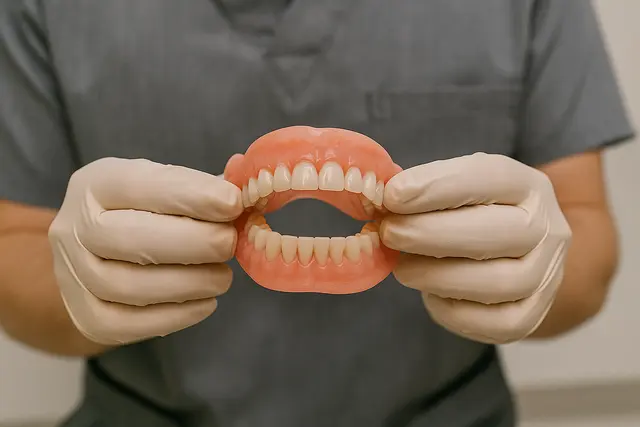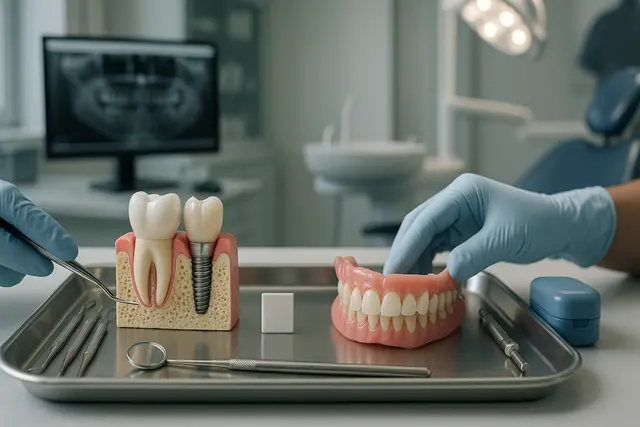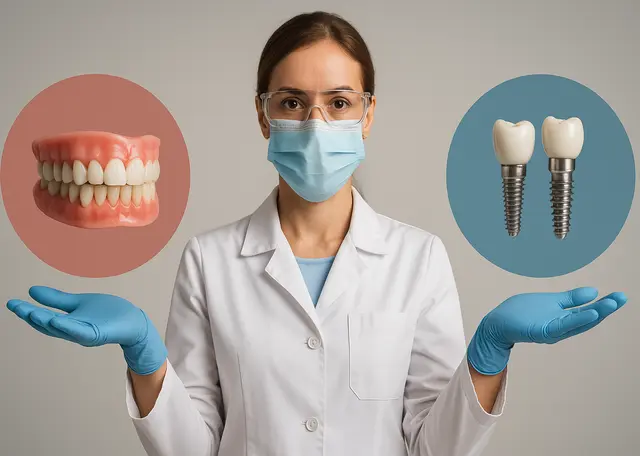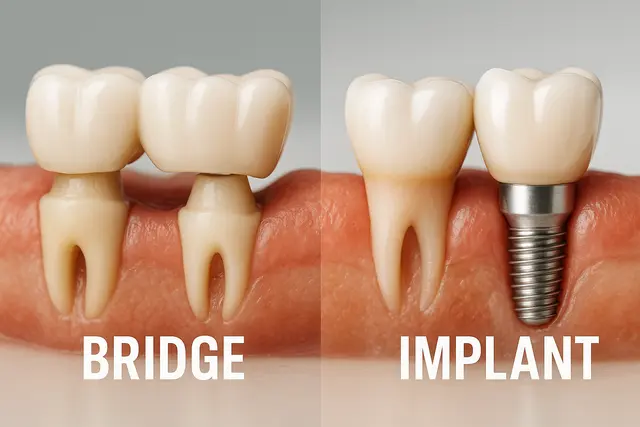Prosthodontics
5 min read
May 23, 2025
What Is an Arch in Dentures? Everything You Need to Know
If you’ve ever sat in a dental chair and heard the word arch thrown around without a clue what it meant, you’re not alone. It’s a simple term with a big impact, especially when it comes to dentures and restoring your smile.

So you’ve heard your dentist mention the word arch during a denture consultation, and now you’re sitting there wondering, what is an arch, anyway? Don’t worry, you’re not the only one. It’s one of those dental terms that gets tossed around like everyone just knows it. But knowing what an arch means (especially in the world of dentures) can help you make smarter, more confident decisions about your dental care, and your smile.
Let’s break it down in real, human terms.
What Is an Arch?
In dentistry, an arch refers to either the upper or lower row of teeth. Yep, just one side. Your mouth has two arches: an upper arch and a lower arch. Think of each arch as a curved bridge holding your teeth in a semi-circular arrangement. That’s why you sometimes hear phrases like “upper arch” or “lower arch” tossed around when discussing treatments or tooth replacement options.
Each arch holds a set of teeth arranged in a semi-circular pattern. When someone says single arch, they’re referring to just the top or just the bottom set of teeth. When you hear full arch, that means the entire row of teeth on either the upper or lower jaw.
What’s an Arch Denture?
An arch denture is a type of denture that’s designed to replace a full row of teeth on either the upper or lower arch. Whether you’re missing teeth in one arch or both, this type of denture is built to fit snugly over your gums and restore the look and function of your natural teeth.
You can have a single arch denture for either the top or bottom, or you might need both if you’re replacing all your teeth. Either way, dentures consist of a gum-colored base and a set of artificial teeth arranged to match a natural bite.
When You Need a Full Arch Denture
A full arch denture is used to replace an entire arch of teeth, meaning all the teeth on the top or bottom are missing. This could be due to injury, gum disease, or just plain wear and tear over the years. Full arch dentures are removable and sit on the gums, often with the help of a bit of suction or denture adhesive to help lock the denture into place.
These are what most people picture when they think of traditional dentures, a full set of teeth that you pop in and out as needed. They're an affordable, non-surgical option for people looking to replace a full set of teeth on either arch.
Dental Arch vs. Arch Denture
Now, don’t get these confused: a dental arch is the natural curved structure in your mouth that holds your teeth, while an arch denture is the manmade version meant to replace it. Dentures are designed to mimic the natural shape and spacing of the dental arch, giving you the best chance of restoring not just your smile, but your bite and oral function too.
The number of teeth in one arch varies a bit, but usually, we’re talking about 14 to 16 teeth per arch. That’s a full row, enough to chew, speak, and grin like you mean it.
Enter: Dental Implants
If you’re not thrilled about removable dentures, or if dentures don’t quite give you the confidence or comfort you’re looking for, you might want to consider a dental implant solution. Implants are small posts placed into the jawbone that act like artificial tooth roots. They help lock the denture into place securely and prevent bone loss in the jaw.
One of the most advanced options in modern restorative dentistry is the full-arch implant.
What Is a Full-Arch Implant?
A full-arch implant system replaces an entire row of teeth using a few strategically placed dental implants (usually four to six per arch). These implants anchor a fixed denture, meaning it stays put, no slipping, no clicking, no cup on the nightstand.
It’s one of the most effective ways to replace all teeth in either the upper or lower jaw. Full-arch implants look and feel like natural teeth and are a game-changer for many patients who want a permanent, stable solution.
Full-Arch Implants vs Traditional Dentures
Let’s call this the ultimate face-off.
Full-arch implants:
Fixed in place
Look and function like natural teeth
Help preserve jawbone
Require surgery
More expensive upfront, but longer-lasting
Traditional dentures:
Removable
May slip or shift
Need adhesive
More affordable initially
Can affect bone density in the long term
Choosing between the two comes down to your lifestyle, health, and budget. A dental professional can help walk you through the pros and cons, and trust us, it’s worth asking every single question you’ve got.
Dental Care for Your Arch Denture
Whether you go for a removable denture arch or an implant-supported denture, keeping things clean is crucial. Dentures require daily cleaning, just like natural teeth, and full-arch implants still need regular checkups and excellent hygiene to protect your gums and long-term oral health.
Regular dental visits (yes, even if all your teeth are artificial) are essential for keeping your smile in great shape.
Why It All Matters
Losing teeth can feel like losing a piece of yourself, but modern dentistry has come a long way. Whether you need a full arch denture, are curious about dental implant procedure, or just want to better understand your options, the bottom line is this: you don’t have to settle for discomfort or insecurity.
From the shape of your arch to the type of denture that fits best, every choice you make is a step toward better dental health, more confident chewing, and a smile that feels like you again.
And remember, arches might sound like a dental buzzword, but at the end of the day, they’re just the foundation of that grin you wear every day. Treat them well.
What Does “Arch” Mean in Dentistry?
In dentistry, an arch refers to either the upper or lower row of teeth in a semi-circular shape. You have two arches, one on top and one on the bottom. When dentists talk about a single arch, they’re referring to just one full row of teeth, either upper or lower.
What Is an Arch Denture?
An arch denture is a custom-made dental appliance that replaces all the teeth in one row, ither the upper or lower arch. It fits over your gums and restores your ability to chew, speak, and smile. You can have one arch denture or a set for both arches, depending on your needs.
How Is a Full-Arch Implant Different From Traditional Dentures?
A full-arch implant uses four to six dental implants to permanently secure a denture to the jawbone, offering better stability and preserving bone health. Traditional dentures, on the other hand, are removable and rest on the gums, which can lead to slipping and long-term bone loss.
Do You Still Need Dental Care With an Arch Denture?
Yes, regular dental care is still important. Whether you wear removable dentures or have implant-supported ones, you’ll need to keep them clean, protect your gums, and visit your dentist regularly to ensure a healthy fit and long-lasting results.
Read Next
Related Posts

Prosthodontics
Implant vs. Dentures Pros and Cons: A Deep Dive into Modern Solutions
Missing teeth can impact more than just your smile, they can affect how you eat, speak, and feel about yourself. Fortunately, modern dentistry offers two leading solutions to bring back both function and confidence: dentures and dental implants. Understanding the pros and cons of each can help you make the choice that fits your needs, lifestyle, and budget.
7 min read
Oct 17, 2025

Prosthodontics
Full Mouth Implants vs. Dentures: Which Is Better for You?
When it comes to replacing missing teeth, the choice between full mouth dental implants and dentures can be overwhelming. Each option has its own set of benefits, limitations, and long-term considerations, making it essential to understand what works best for your needs, health, and lifestyle.
5 min read
Oct 17, 2025

Prosthodontics
Tooth-Supported Bridge vs. Implant Comparison: Benefits, Drawbacks, and Insights
Deciding between a dental bridge and a dental implant can feel overwhelming, especially when both options promise to restore your smile and improve oral function. Each solution comes with its own set of benefits, considerations, and ideal use cases, making it essential to understand how they compare before choosing what’s right for you.
6 min read
Oct 17, 2025
Don’t have time to research every dentist around you?
See why 30k+ patients trusted us